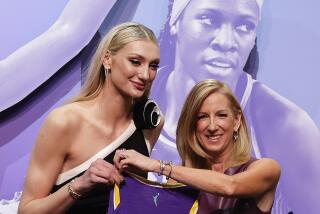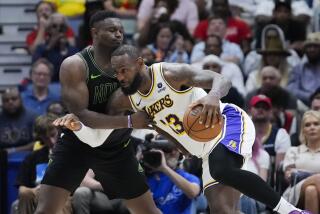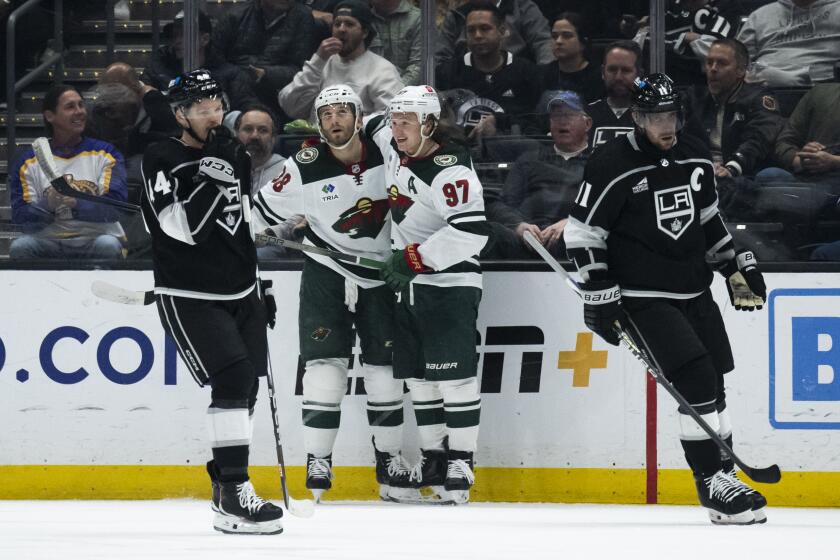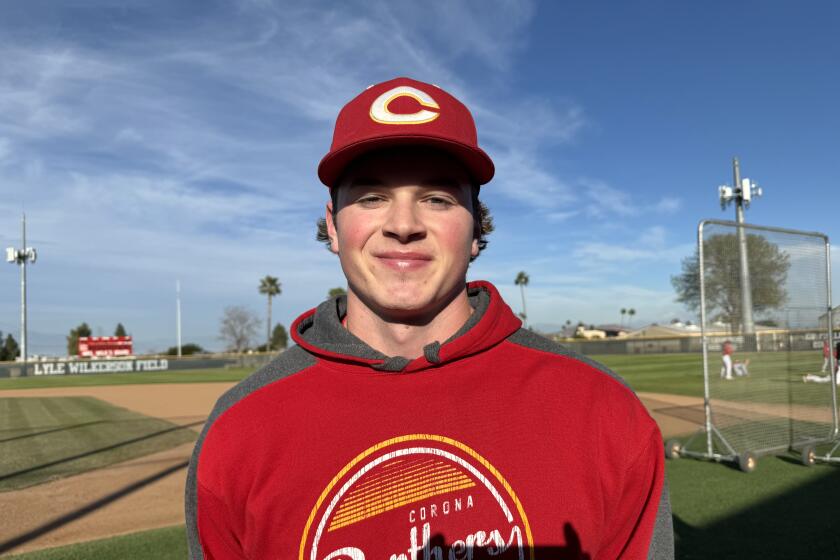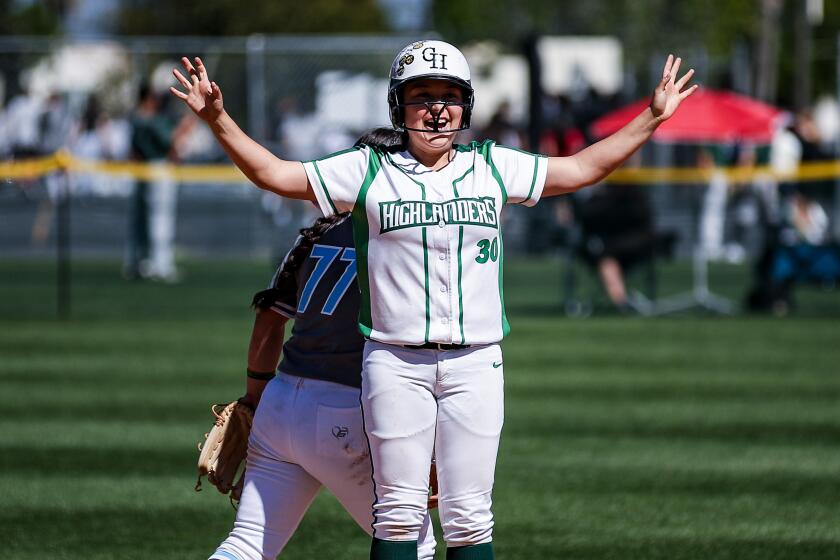THE LEAPING LEGENDS OF BASKETBALL : SOME OF THE NAMES WILL JUMP OUT AT YOU, OTHERS WON’T; BUT ALL OF THEM TOOK THEIR GAMES TO LOFTY HEIGHTS
Stand underneath a basketball hoop, a regulation 10-footer.
Look up. Lift up an arm and hop once or twice to get a feel for how far away the rim is.
Don’t try a big leap. I don’t want anyone ripping rib-cage muscles or wrenching spinal disks. This story is not that important.
Now imagine yourself crouching a bit, like Superman, and springing high into the air. Imagine yourself lifting off the blacktop, up and up, until you can reach into the air far above the rim.
There. That’s the outer space we’re dealing with today, the sky above the hoop, the rare air inhabited by only a select group of humans, the legendary leapers.
If you’ve got a good imagination, imagine yourself wearing a baseball cap, and leaping so high, arms at your side, that you flick your head sideways and dunk your cap. Ridiculous, but it has been done, by a kid you’ve probably never heard of, unless you started reading this story at the end.
The players who fly through this thin air are not simply remembered by hoop fans. They are enshrined in a mythical Museum of Leap.
These are not necessarily great basketball players, understand, but their ability to jump has made them objects of something much deeper than profound respect.
I was phoning the Charlotte Hornets to reach David (Skywalker) Thompson, who now works in the team’s front office, when a female secretary said: “I’ve only seen two players who did things that I watched and I didn’t believe--David, and Michael Jordan. The only other thing in life I couldn’t comprehend was looking at the moon and knowing there were men walking on it.”
The greatest nicknames in basketball are reserved for those who attain the greatest altitude.
Skywalker, Helicopter, Elevator, Clyde the Glide, Air Jordan, the Hawk, Rodan, Pogo Joe, Honeycomb, Sidecar, the Big Dipper, the Human Highlight Film, Sky King, Kangaroo Kid.
These are professional men: Dr. J, Dr. Dunkenstein, Dr. Jam.
These are true royalty: Sir Jamalot, Sir Slam, the Prince of Midair.
These men have their own ancient orders, such as Phi Slama Jama, the mythical fraternity created during the 1982-83 college season by Houston scribe Thomas Bonk, now a Times writer, to honor the dunk-happy University of Houston Cougars.
In the far-up Land of Leap, the unit of currency is the dunk. And the problem these days is inflation. Everybody dunks. Dunk is cheap.
“I see kids in the eighth grade, kids 5-11, dunking behind their heads,” said Rod Thorn, former National Basketball Assn. star and now the league’s vice president of operations.
When Dominique (the Human Highlight Film) Wilkins was in college, a 5-9 laundry man named Leroy Nowells would saunter into the Georgia gym and match slams with Wilkins. It was the Human Highlight Film vs. a Selected Short.
There are celebrity dunk-offs. Mike Conley, who is 6-2 and a triple jumper, won the Foot Locker Slam Dunk Contest last weekend, with 6-2 Raider receiver Tim Brown finishing third and swimmer Matt Biondi in the top five.
The color barrier and the sex barrier of slam-dunk have fallen: Many white guys and a few women can dunk.
Hey, a sportswriter dunks. Curtis Bunn, a 6-1 reporter for Newsday, has a very decent repertoire of slams. Could this be God’s way of telling us it’s time to raise the hoop?
I mean, what next? Dunk-off of the Network Superstars?
In today’s semifinals, folks, we’ll see Gary (Up in the Airy) Coleman vs. Bea (the Flea) Arthur, and Jumpin’ Johnny Carson vs. Pogo Stick Peter Jennings.
“It takes a lot more to get people excited now,” said Chris Wallace, editor of the Blue Ribbon College Basketball Yearbook. “It’s almost like burlesque dancing. When they were not taking everything off, the dancing was more alluring. Now they take everything off and it takes a lot more to get people excited.”
Still, the thrill is not all gone. The new generation of jumpers, ushered in by Julius Erving, has pushed the dunk to new artistic heights. Michael Jordan has stopped just short of holding the ball in his mouth, uncoiling his tongue in mid-flight and inventing the Anteater Slam.
And despite the proliferation of dunkers, there is a very elite group of leapers. In the NBA, where everyone can dunk--you wouldn’t even want to rule out David Stern--there are really only a few top guns.
One expert, Mitch Kupchak, the Lakers’ assistant general manager, was asked to name the game’s bona fide super leapers. He came up with four: Jordan, Dominique Wilkins, Spud Webb and Clyde (the Glide) Drexler.
Close to the superleaper class in Kupchak’s book, but a shade short, are Charles Barkley, Larry Nance, Orlando Woolridge, Roy Hinson, Tom Chambers and Akeem Olajuwon.
A lot of young men soar into the NBA but are quickly weighted down by injuries and the 82-game grind, such as Darrell (Dr. Dunkenstein) Griffith of the Utah Jazz.
No question, the mystique of the superleaper remains.
One explanation for the reverence accorded the big jumpers is offered by psychologist-sportscaster Bob Costas, who once did play-by-play for the Spirit of St. Louis, a team in the now-defunct American Basketball Assn., where every game was a jam-boree.
“People think, mistakenly in most cases, that they could hit a baseball,” Costas says. “They think they could track down what the announcer calls a routine fly ball. They couldn’t, of course, because those things are so much harder than they look. But with a leaper, everybody instantly knows they couldn’t do it, that only the tiniest fraction of humans can jump that high.”
Why not simply whip out a tape measure and measure the leapers’ leaps, take the guesswork out of who’s the greatest?
Forget it.
We ask the player to stand next to a wall, flat-footed, one arm stretched to its maximum, and mark the apex of his fingers. Then we ask him to jump and we mark the highest point he touched. The difference between the two marks, in inches, is the player’s “sergeant jump,” as in, “Joe Smith has a 29-inch sergeant.”
Claims of sergeants in the mid- and high 40s are common. However, you can take all the sergeant numbers of all the jumping jacks, put the numbers in a manure spreader and sprinkle them on your lawn or garden. Instant green.
Tom Nissalke, an assistant coach at Milwaukee when Kareem Abdul-Jabbar came into the league, and later head coach of the Utah Jazz and Houston Rockets, says he always had his players measured, and the best sergeant he ever saw was a 35, by Darrell Griffith as a rookie.
“Jack Gardner, a former college coach, did our testing,” Nissalke said. “He had tested thousands of Navy pilots during the war, and he said Griffith’s was the highest he ever measured.”
Chris Wallace, the college talent scout, said: “I don’t believe measurements. Keith Smart always reported he had a 44. At (one NBA tryout camp), where we had a strong cross section of draftees, the highest was 36 1/2 inches. Keith had a 32. I told him I’d read he had a 44. He said he was tired and tight.
“Most of the players had between 29 and 33, so I don’t believe any of that stuff in the 40s.”
Wilt Chamberlain claims that his sergeant, during his prime, was “46 to 48 inches, easy.” Of course, Wilt also claims he once averaged 50 points for an entire NBA season, so his credibility is suspect.
There are two other pure measurements of leap--the dunk and the top of the money exchange.
Until recently, nobody ever tried to keep track of dunks on any league-wide scale. The breakthrough occurred when Harvey Pollack, the venerable stat whiz of the Philadelphia 76ers, collected dunk data from every team for the entire 1987-88 NBA season, accounting for every last slammeroo.
Last season, there were 5,757 NBA dunks by 246 players. The single-game high was eight, by Drexler, against the Lakers.
The most frequent flyers? Eight players dunked in triple figures: Barkley of Philadelphia, 188; Jordan of Chicago, 156; Otis Thorpe of Golden State, 150; Pat Ewing of the Knicks, 146; Karl Malone of Utah, 142; Drexler of Portland, 130; Wilkins of Atlanta, 126, and Olajuwon of Houston, 118.
Detroit’s Adrian Dantley, 6-foot-4, and Cleveland’s Phil Hubbard, 6-8, were the only front-court starters to go through the season dunkless.
The other measurement of leap is the money exchange at the top of the backboard, which is exactly 13 feet above the floor and three feet above the rim.
This is where we get into sword-and-stone mythology.
Legends abound of the truly great leapers who could touch the top of the board. Almost always the feat involves money--claims that the player could grab a dollar bill off the top of the board, or could pluck off a quarter and leave two dimes and a nickel change. Spencer Haywood, for one, claims to have been to the top.
“I defy anyone to say they took change off the top of the backboard,” Chamberlain said. “I could. Someone would put a quarter up and I’d snatch it down.
“I’ve heard stories about Jackie Jackson doing it, but I’ve never seen anyone (but himself) come close.”
Sonny Hill, a Philadelphia leaping legend of the ‘60s, backs Wilt, saying, “The only man that’s been to the top, that’s Wilt. I asked Kareem if he ever did, and he could jump a little bit. He told me, ‘Sonny, no.’ ”
Nissalke tells of an informal leaping contest between second-year man Kareem, who then was Lew Alcindor, and Milwaukee forward Don Smith, who now is Zaid Abdul-Aziz.
“They were trying to touch the top of the board,” Nissalke said. “They took about 10 jumps each. Kareem came the closest. He was about a foot from the top.”
Mitch Kupchak witnessed a similar jump-off among 6-4 David Thompson, 6-9 Marvin Barnes and 7-4 Tom Burleson.
“David came the closest,” Kupchak said. “He was six or eight inches away. I don’t believe anyone has ever done it. If you play the game, you know how high that is. You’re entering another world up there. No man, I don’t believe, has been up that far.”
With Chamberlain over 50--years of age, not points per game--Nissalke feels safe in saying, “That would be the ultimate challenge: Bet any amount of money, and you wouldn’t find anyone who could come close to the top of the board.”
Don’t send letters, leapers. Send us your videotape. Geraldo Rivera is standing by.
In our museum of hoop flight, there is a special wing for the charter members, the dinosaurs of dunk.
No. 1 in everyone’s heart and myths is Jumpin’ Jackie Jackson, also known as Sidecar Jackson. Not a great deal is known about Jackie, which is good, because nothing dims a legend faster than facts.
We know he was born in New Bern, N.C., grew up (and flew up) in Brooklyn, attended Virginia Union, then played several years for the Harlem Globetrotters and in the old Eastern League.
The Globies listed him at 6-5, but Sonny Hill swears Jackie was 6-3, tops.
“I have seen everybody,” Hill said. “Julius, Gus (Johnson), Pogo Joe Caldwell. The greatest leaper I ever saw was Jackie. Nobody ever played the game could rise any better than Jackie.
“I saw him come down the floor once, in the Eastern League, on a fast break. Jay Norman, an outstanding defensive player, went into his defensive stance at the foul line. Jackie took off, jumped over Norman’s head and dunked the ball.”
Another oft-told legend has Jackie on defense. His man takes him into the key, gives a head fake and sends Jackie skyward. The man waits and waits for Jackie to start coming down, but waits too long. Jackie stays in the air and the ref calls a three-second violation.
Chamberlain remembers other playground legends:
“Boy named Helicopter (real name: Herman Knowings) had incredible wingspan. His jump was absolutely awesome. He had wide shoulders--he was built like Orlando (Woolridge), 6-7 or 6-8. He would get up in the air and spread those wings, he’d be swoopin’.
“One boy did dunks of a monster nature, so they named him after the only monster they knew that could fly--Rodan.
“There was a Philadelphia boy, Sonny Hill, about 5-10 (actually 5-9), he was the first guy that size I ever saw dunk. In those days, didn’t nobody dunk but Wilt Chamberlain, so Sonny was an absolute marvel.”
Earl Manigault was another fabulous flyer off the Eastern blacktop in the late ‘50s and early ‘60s. The 6-2 product of the Harlem slums could dunk, catch the ball with his opposite hand and dunk it again, all in the same leap.
The obvious question is, why didn’t more of these guys play in the NBA?
Several reasons.
Most of these leapers are black, and in the late ‘50s and early ‘60s, the NBA still had unofficial quotas, and only eight or nine teams.
Most of these leapers were from the inner city, where they suffered from overexposure to drugs and underexposure to formal education.
Manigault, for instance, developed an addiction to heroin, stole to get it, did time in two prisons. He finally got a pro tryout with the Utah Stars of the ABA at 25, but by then his fabulous springs were sprung.
Connie Hawkins, another of the elite leapers of that era, was blackballed from the NBA because of involvement with gamblers when he was in college. He was never even charged with wrongdoing, but the NBA ban stuck until Connie’s lawyers broke it down in 1969, when the Hawk was 27 and well past his swooping prime.
Many of the great leapers of that era inhabited the fringes of reality as we know it. They were like jazz musicians in sneakers.
“A lot of them, you have to understand, weren’t able to get into college,” Chamberlain said. “Basketball was just a game they played for fun. And some colleges and pro teams were not ready to take chances on what went along with those guys.
“Some of them were pretty damn eccentric. I’ll give you an example. This guy wasn’t a leaper, but it will show you what I mean. There was a guard from Harlem named Rabbit. He was so good, Red Auerbach saw him play in a schoolyard game and invited him to camp with the Celtics.
“For three days, Rabbit put on a show like they’ve never seen before. He played circles around a guy named Robert Cousy. After three days, Rabbit said to Red, ‘One of us is gonna have to go.’
“Red said, ‘What do you mean?’ Rabbit said, ‘Either get rid of Bob Cousy or get rid of me. There’s not room for both of us.’ The next day Red let Rabbit go. He came on back to Harlem. It didn’t make no difference to him.”
A few of the big-time leapers did make it--Jumpin’ Johnny Green, Pogo Joe Caldwell and Tommy (the Hawk) Hawkins, who was a Laker rookie when the team moved to Los Angeles in 1960. Hawkins is now vice president of communications for the Dodgers.
The Hawk’s favorite flight story, like many stories of that era, features Chamberlain as a foil.
“We’re playing in Philadelphia, against Wilt,” Hawkins relates. “I get a rebound and I’m driving up the floor, ready to go coast to coast. Wilt meets me at mid-court and says, ‘Na, na, na, not this time.’
“I said to myself, ‘I’ve got to try.’ I angled to the right. I knew he was right there with me. I made a left turn at the baseline, flew under the basket to the other side, put it through his arms, and dunked it with two hands over my head.
“I said to him, ‘Yes, yes, yes!’ Wilt said, ‘I’m gonna kill you.’ ”
Many of the legendary leapers of that era didn’t play NBA ball because all they could do was leap. Jackie Jackson’s all-around game, by most accounts, was only fair.
One dunking dinosaur who could fly and play was Gus Johnson, a 6-6 hipster-forward who had a gold star implanted in a front tooth. Gus was a colorful thunder dunker and a breaker of backboards. He played nine seasons for the Baltimore Bullets, beginning in ‘63, and he died last year.
Every time Gus slam-dunked at home, the recorded sound of a rifle shot would whistle through the arena.
Gus once said, “When I dunked that ball and heard that shot for the first time, I said to myself, ‘Oh, oh, Gus. Somebody done gotcha.’ But man, that was sweet music. It sure did make me feel good inside.”
The matter of color:
A person who is a poor leaper is said to have “white man’s disease.” White guys use the expression, black guys use it, mostly in a spirit of good fun.
In the six years of the NBA’s slam dunk contest, only one white player has been invited to compete, 6-10 Tom Chambers in 1986. He finished well out of the running--or jumping--when he clanged at least one attempt off the rim.
There have been--and are--very good white jumpers. Jerry West could get up. Billy Cunningham wasn’t nicknamed the Kangaroo Kid because he had a pouch. Bobby Jones could swoop and soar. Stanford’s 6-4 Todd Lichti is a big-time leaper, regardless of race, creed or color.
Chamberlain was asked, weren’t there any great leapers of the white persuasion?
Wilt mentioned a few names, then said, “You know, there was a white boy who played for Atlanta around 1970. Never got off the bench, but in warmups he could dunk better than anyone I’ve ever seen.”
Chamberlain couldn’t remember the player’s name, but Rod Thorn did. The mystery leaper was--and is--Herb White, 6-foot-2, eyes of blue, from Decatur, Ga.
As with most leaping legends, Herb’s aerial reputation often preceded him. As a high school senior, he received a scholarship offer from a Midwestern college, asking him to become the school’s first black player. Instead he went to Georgia as a white player and was a so-so power forward.
Before his senior year, White happened to work out with some Atlanta Hawks players and they went to coach Richie Guerin with tales of this amazing leaper. Herb was not drafted, but was invited to Hawks’ camp after his senior year and made the 1970-71 team as a point-guard backup and road roommate of another rookie, Pete Maravich.
White started five games, but was mostly a mop-up guy, then was injured and finished his career in a pro league in Mexico.
White, also known as the Elevator from Decatur, made the NBA all-time all-warmup team that one season. Pregame warmups were his showtime. He would perform a reverse dunk-dunk with two balls. He would toss the ball off the backboard and then slam it home. In Madison Square Garden, he got a standing ovation for his warmup dunks.
“I won the unofficial NBA slam dunk title that season,” said White, who now sells heavy equipment in Georgia. “In warmups, we would always check out the other team and get into little contests with their guys. All the teams did that. By word of mouth, you would get to know who the best dunkers were, and by the end of the season it was pretty much agreed the best two were a Portland guy named Claude English and me.
“We played Portland in the last game of the season. Before the game, English and I went back and forth. Finally he did a 360, one handed. So I did a 360, two handed, and he conceded.”
White is a regular at Hawk games and a fan of Wilkins. Can the old Elevator still ascend?
“On a good day,” he said. “About a year ago, I was in a playground game with some black guys. I got fired up and did a 360 dunk. I went back a few hours later with a tape measure. The rim was two inches low. I said, ‘What the hell, I’m 40.’ ”
If the Land of Leap had a national holiday, it would be Feb. 8, the anniversary of the legendary 1976 ABA All-Star game’s first--and last--slam dunk contest. The NBA had no such contest at the time, considering such frivolity to be beneath the senior league’s dignity.
The ABA wasn’t about dignity, it was about style. You don’t play with a red, white and blue ball if you’re into dignity.
That Feb. 8, the ABA trotted out its five best slammers. Artis (A-Train) Gilmore, George (Ice) Gervin and Larry (Big Cat) Kenon all dunked admirably. But the final came down to David Thompson vs. Julius Erving--the Skywalker vs. the Doctor.
The Doc won it with a long run, a leap from two inches inside the free throw line and a dramatic, powerful windmill slam. Thompson, as a consolation prize, won the MVP award in the All-Star game itself.
The ABA folded after that season, but the slam-off was such a hit with the media that the concept was eventually ripped off by the NBA. And that performance in Denver was the national coming-out party for Dr. J, the godfather of dunk. He was discovered.
If we were to honor dunkers as we honor actors, Doc would be given a statuette for his body of work. With the exception of Chamberlain, Dr. J was the first superleaper who was also a superstar NBA player, and the first big-time player to exploit the dunk as an art form at the pro level.
Thompson was on a par with Erving but after five great NBA seasons, his career hit a quick decline, caused in part by cocaine problems.
Erving’s early obscurity helped make him famous. Unlike Thompson, a huge star at North Carolina State, Dr. J kind of sneaked up on the basketball world. He was all but unknown at the University of Massachusetts, then played five seasons in the semi-secret ABA.
“Part of Dr. J’s legend is the same as the mystique of a gunfighter coming into town,” Costas said. “It was like, ‘Legend has it that 20 men are buried in Boot Hill because of this guy. But who has seen him?’ ”
By the time Dr. J got to the NBA, in 1976 at the age of 26, more than 25% of his leg spring--by his estimate--was shot. Even so, Erving was the NBA’s most dazzling aerial star until he retired in 1987 and passed the title to Michael Jordan.
In the Museum of Leap, Wilt (the Big Dipper) Chamberlain has his own wing. Who would he share a wing with? We should be glad he doesn’t demand his own useum.
Very tall players are seldom recognized as great leapers. If they play the game far above the rim, it is because they are tall. So goes the popular assumption.
“What’s unfortunate is that most people regard the great leapers as being only the short guys who could dunk,” said the 7-1 1/16 Chamberlain. “My sergeant was higher than Jordan’s. When I went to Kansas, they had a 12-foot basket in the gym, because Dr. Phog Allen was advocating the 12-foot basket. I used to dunk on that basket. It was an effort, but I could do it.”
There is no documented proof of a man ever taking off from behind the free-throw line, 15 feet from the backboard, and dunking. But listen to Wilt. “When I was a freshman, I fooled around with shooting free throws this way: For some reason, I thought you had to stay within the top half of that free-throw circle, so I would step back to just inside the top of the circle, take off from behind the line and dunk. They outlawed that, but I wouldn’t have done it in a game, anyway. I was a good free throw shooter in college.”
Actually he was a 62% free throw shooter, which is poor except in comparison to his 51% as a pro.
Chamberlain played for the Globetrotters in the ‘58-59 season and said: “Jumpin’ Joe Buckhalter and I would line up on opposite sides of the free throw lane when Meadowlark Lemon was shooting a free throw. He’d shoot it short and Joe and I would leap up and shake hands over the basket.”
The greatest jumper today? If you give bonus points for obscurity and mystery, it would be Joey Johnson, younger brother of Celtic guard Dennis.
Dennis never was much of a leaper. Joey? He can’t quite jump out of the gym, but he has come close to jumping out of a bar or two.
Joey is 6-3, with average-length arms and legs, and incredibly unaverage spring.
Joey was a good player at Banning High in Wilmington and spent two years at the College of Southern Idaho, a junior college. Then he transferred to Arizona State, clashed with then-coach Steve Patterson and wound up quitting the team. Right now Johnson is red-shirting at ASU.
He may be the greatest leaper of all time.
Joe Clarke, founder and president of the South-Central L.A. Athletic Club, has worked with most of the great L.A. prep stars of the last two decades. When Joey was a high school senior, Clarke took his Watts Magicians to Mesa, Ariz., for a prep tournament.
Joey made the trip but was nursing a hip pointer, so he couldn’t suit up. He was in the gym in Mesa one afternoon, in street clothes and basketball shoes. Some of the guys started dunking.
“Joey didn’t even have his shoes laced,” Clarke said. “He had a baseball cap on, and he turned the bill sideways. He stood below the basket, no run, just jumped straight up with his arms at his sides, flipped his head sideways and dunked his cap.”
At Southern Idaho, the legend grew. As a freshman he went out for the track team, worked out a total of 10 hours, then high-jumped 7-3 7/8. As a sophomore, with as little work, he improved to 7-5 7/8.
At halftime of one Southern Idaho game, Joey was pursuaded to give a brief high-jump demonstration. In his basketball uniform and shoes, with a short, unmeasured run-up, he soared over seven feet.
“People swear he cleared it by a foot,” said Fred Trenkle, Southern Idaho’s basketball coach. “I was right there and it wasn’t a foot. But he was over by a good six to eight inches. He walked into the gym one morning and there was a TV crew set up. They asked him to show how high he could jump, so with no warmup of any kind, in his school clothes, Joey stood there, jumped up and put his chin on the rim. I’ve got the videotape to prove it.”
Karl Kleinkopf, who coached the Southern Idaho track team for nine years, said: “There’s absolutely no doubt Joey could be an eight-foot high jumper by 1992. Very easily.”
There is a tavern called the Corner Club, in Moscow, Ida. It is near the University of Idaho campus, where the legendary Gus Johnson once played. In 1962, Johnson jumped and touched a spot high on the wall, and a nail was driven into the spot to commemorate the unbelievable leap.
Trenkle had heard of the Gus Johnson nail, so when the Southern Idaho team was passing through Moscow on a trip, he ordered the bus driver to stop outside the Corner Club, and he took Joey inside.
“We’d been on the bus eight hours by then,” Trenkle said. “Joey walked up to the wall, one foot planted, no rocking, jumped up and missed the nail. He said he was afraid he would cut himself. So he tried it again, grabbed the nail and bent it straight down. They drove a new nail in for Joey, measured it at 11-7 1/2. My mother has a bar here in southern Idaho, and she’s got a nail where Joey touched, at 11-9 1/2.”
But can he play the game?
Joey averaged 19.5 points at Southern Idaho and led the team to a national junior college title. He was an incredible shot blocker. In the JC championship game, an opponent fired a jump shot at the buzzer. Joey, standing about eight feet from the shooter, leaped and slapped the shot away.
He dunked 11 times in one game.
Said Trenkle: “He can take the ball with his right hand, go up, put it between his legs and dunk it behind his head with his left hand. Effortless, absolutely effortless.”
Patterson, who recently resigned as Arizona State’s coach, said that Johnson is really an impact player, but not consistently good and solid.
“My perception is, with players that rely on their jumping ability, they reach a certain level of competition where their fundamental skills have to kick in, they have to become a basketball player,” he said. “A lot of great leapers don’t bother to perfect those skills, because they are treated with such awe. I also think, in Joey’s case, he gets up so high it hurts his shooting technique.”
The leaper’s curse.
Clarke said: “When other players were shooting jump shots in their back yards, Joey was practicing dunks.”
Has Joey Johnson simply outleaped the game of basketball? We’ll find out next season.
The soaring flight of the great leaper is amazing, even to himself.
“It’s a rush, a thrill,” said the Elevator from Decatur. “I’ve never felt another feeling like it, being able to go up in the air, over someone much bigger, and stay up there. It’s a feeling of power and freedom I’ve never gotten from anything else. You’re just up there and nobody else can get up there.”
David (Skywalker) Thompson said: “Sometimes I’d surprise myself. It’s almost like you were floating, like there was no such thing as gravity. There’s no greater feeling than going up in a crowd, over guys a foot taller.”
Tommy (the Hawk) Hawkins said: “If you can think about Peter Pan, that’s the feeling. Some nights, when your legs were really there and you had total command, you felt nobody was going to get any higher than you were. It’s like walking on air. You’d go up, arch your back, and go up even higher. Some nights I’d scare myself.”
Herb White was moved to write a poem about an eagle that had lost its ability to soar.
However, the poet laureate of leap is Darryl Dawkins. Now an NBA journeyman, Dawkins came into the NBA in 1975, straight out of high school, billed as the center of the future. The future never came, but Dawkins broke new ground in power dunking, backboard shattering and dunknaming.
Dawkins claimed to have come from the planet Lovetron, he called himself Chocolate Thunder and Zandokan the Mad Dunker, and he named his dunks. A sample: In Your Face Disgrace, Sexophonic Turbo Delight, Hammer of Thor, and Yo Mamma.
His masterpiece was a backboard shattering dunk over Kansas City forward Bill Robinzine. Dawkins named it, “Chocolate Thunder Flying, Robinzine Crying, Teeth Shaking, Glass Breaking, Rump Roasting, Bun Toasting, Wham, Bam, Glass Breaker, I Am Jam.”
No discussion of legendary leapers is complete without heated debate. To that end, here’s this writer’s all-time all-leap team:
Dr. J, the Big Dipper, Air Jordan, David Skywalker and Joey Johnson.
More to Read
Get our high school sports newsletter
Prep Rally is devoted to the SoCal high school sports experience, bringing you scores, stories and a behind-the-scenes look at what makes prep sports so popular.
You may occasionally receive promotional content from the Los Angeles Times.
